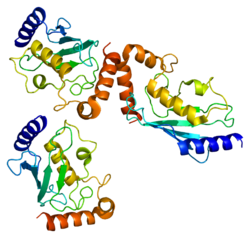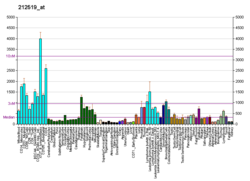UBE2E1
| UBE2E1 | |||||||||||||||||||||||||||||||||||||||||||||||||||
|---|---|---|---|---|---|---|---|---|---|---|---|---|---|---|---|---|---|---|---|---|---|---|---|---|---|---|---|---|---|---|---|---|---|---|---|---|---|---|---|---|---|---|---|---|---|---|---|---|---|---|---|
 | |||||||||||||||||||||||||||||||||||||||||||||||||||
| |||||||||||||||||||||||||||||||||||||||||||||||||||
| Identifiers | |||||||||||||||||||||||||||||||||||||||||||||||||||
| Aliases | UBE2E1, UBCH6, ubiquitin conjugating enzyme E2 E1 | ||||||||||||||||||||||||||||||||||||||||||||||||||
| External IDs | OMIM: 602916; MGI: 107411; HomoloGene: 84372; GeneCards: UBE2E1; OMA:UBE2E1 - orthologs | ||||||||||||||||||||||||||||||||||||||||||||||||||
| EC number | 2.3.2.24 | ||||||||||||||||||||||||||||||||||||||||||||||||||
| |||||||||||||||||||||||||||||||||||||||||||||||||||
| |||||||||||||||||||||||||||||||||||||||||||||||||||
| |||||||||||||||||||||||||||||||||||||||||||||||||||
| |||||||||||||||||||||||||||||||||||||||||||||||||||
| |||||||||||||||||||||||||||||||||||||||||||||||||||
| Wikidata | |||||||||||||||||||||||||||||||||||||||||||||||||||
| |||||||||||||||||||||||||||||||||||||||||||||||||||
Ubiquitin-conjugating enzyme E2 E1 is a protein that in humans is encoded by the UBE2E1 gene.[5][6]
Function
The modification of proteins with ubiquitin is an important cellular mechanism for targeting abnormal or short-lived proteins for degradation. Ubiquitination involves at least three classes of enzymes: ubiquitin-activating enzymes, or E1s, ubiquitin-conjugating enzymes, or E2s, and ubiquitin-protein ligases, or E3s. This gene encodes a member of the E2 ubiquitin-conjugating enzyme family. Two alternatively spliced transcript variants encoding distinct isoforms have been found for this gene.[6]
Interactions
UBE2E1 has been shown to interact with Ataxin 1[7] and NEDD4.[8][9]
References
- ^ a b c GRCh38: Ensembl release 89: ENSG00000170142 – Ensembl, May 2017
- ^ a b c GRCm38: Ensembl release 89: ENSMUSG00000021774 – Ensembl, May 2017
- ^ "Human PubMed Reference:". National Center for Biotechnology Information, U.S. National Library of Medicine.
- ^ "Mouse PubMed Reference:". National Center for Biotechnology Information, U.S. National Library of Medicine.
- ^ Nuber U, Schwarz S, Kaiser P, Schneider R, Scheffner M (Mar 1996). "Cloning of human ubiquitin-conjugating enzymes UbcH6 and UbcH7 (E2-F1) and characterization of their interaction with E6-AP and RSP5". J. Biol. Chem. 271 (5): 2795–800. doi:10.1074/jbc.271.5.2795. PMID 8576257.
- ^ a b "Entrez Gene: UBE2E1 ubiquitin-conjugating enzyme E2E 1 (UBC4/5 homolog, yeast)".
- ^ Hong S, Lee S, Cho SG, Kang S (Jun 2008). "UbcH6 interacts with and ubiquitinates the SCA1 gene product ataxin-1". Biochem. Biophys. Res. Commun. 371 (2): 256–60. doi:10.1016/j.bbrc.2008.04.066. PMID 18439907.
- ^ Anan T, Nagata Y, Koga H, Honda Y, Yabuki N, Miyamoto C, Kuwano A, Matsuda I, Endo F, Saya H, Nakao M (Nov 1998). "Human ubiquitin-protein ligase Nedd4: expression, subcellular localization and selective interaction with ubiquitin-conjugating enzymes". Genes Cells. 3 (11): 751–63. doi:10.1046/j.1365-2443.1998.00227.x. PMID 9990509. S2CID 1653536.
- ^ Malakhova OA, Zhang DE (Apr 2008). "ISG15 inhibits Nedd4 ubiquitin E3 activity and enhances the innate antiviral response". J. Biol. Chem. 283 (14): 8783–7. doi:10.1074/jbc.C800030200. PMC 2276364. PMID 18287095.
Further reading
- Pickart CM (2001). "Mechanisms underlying ubiquitination". Annu. Rev. Biochem. 70: 503–33. doi:10.1146/annurev.biochem.70.1.503. PMID 11395416.
- Chen P, Johnson P, Sommer T, Jentsch S, Hochstrasser M (1993). "Multiple ubiquitin-conjugating enzymes participate in the in vivo degradation of the yeast MAT alpha 2 repressor". Cell. 74 (2): 357–69. doi:10.1016/0092-8674(93)90426-Q. PMID 8393731. S2CID 205020910.
- Anan T, Nagata Y, Koga H, Honda Y, Yabuki N, Miyamoto C, Kuwano A, Matsuda I, Endo F, Saya H, Nakao M (1998). "Human ubiquitin-protein ligase Nedd4: expression, subcellular localization and selective interaction with ubiquitin-conjugating enzymes". Genes Cells. 3 (11): 751–63. doi:10.1046/j.1365-2443.1998.00227.x. PMID 9990509. S2CID 1653536.
- Nyman TA, Matikainen S, Sareneva T, Julkunen I, Kalkkinen N (2000). "Proteome analysis reveals ubiquitin-conjugating enzymes to be a new family of interferon-alpha-regulated genes". Eur. J. Biochem. 267 (13): 4011–9. doi:10.1046/j.1432-1327.2000.01433.x. PMID 10866800.
- Lenk U, Sommer T (2000). "Ubiquitin-mediated proteolysis of a short-lived regulatory protein depends on its cellular localization". J. Biol. Chem. 275 (50): 39403–10. doi:10.1074/jbc.M006949200. PMID 10991948.
- Pringa E, Martinez-Noel G, Muller U, Harbers K (2001). "Interaction of the ring finger-related U-box motif of a nuclear dot protein with ubiquitin-conjugating enzymes". J. Biol. Chem. 276 (22): 19617–23. doi:10.1074/jbc.M100192200. PMID 11274149.
- Ito K, Adachi S, Iwakami R, Yasuda H, Muto Y, Seki N, Okano Y (2001). "N-Terminally extended human ubiquitin-conjugating enzymes (E2s) mediate the ubiquitination of RING-finger proteins, ARA54 and RNF8". Eur. J. Biochem. 268 (9): 2725–32. doi:10.1046/j.1432-1327.2001.02169.x. PMID 11322894.
- Lehner B, Semple JI, Brown SE, Counsell D, Campbell RD, Sanderson CM (2004). "Analysis of a high-throughput yeast two-hybrid system and its use to predict the function of intracellular proteins encoded within the human MHC class III region". Genomics. 83 (1): 153–67. doi:10.1016/S0888-7543(03)00235-0. PMID 14667819.
- Takeuchi T, Iwahara S, Saeki Y, Sasajima H, Yokosawa H (2005). "Link between the ubiquitin conjugation system and the ISG15 conjugation system: ISG15 conjugation to the UbcH6 ubiquitin E2 enzyme". J. Biochem. 138 (6): 711–9. doi:10.1093/jb/mvi172. PMID 16428300.
External links
- PDBe-KB provides an overview of all the structure information available in the PDB for Human Ubiquitin-conjugating enzyme E2 E1 (UBE2E1)
- v
- t
- e
-
 1y6l: Human ubiquitin conjugating enzyme E2E2
1y6l: Human ubiquitin conjugating enzyme E2E2
 | This article on a gene on human chromosome 3 is a stub. You can help Wikipedia by expanding it. |
- v
- t
- e
















